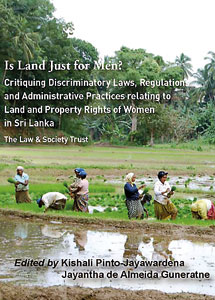In the late 1980s, when I was working on my book A Field of One’s Own (1994), I was struck by the dramatic difference between Sri Lanka and the rest of South Asia in the rights women enjoyed in immovable property, especially land.
In Sri Lanka every community, irrespective of religion and ethnicity, customarily recognized women’s rights in land and other immovable property, albeit varyingly by regions, and typically unequal to men’s. That the Sinhalese Buddhists, the Hindu Tamils and the Muslims all recognised women’s property rights, highlighted the fact that it was local culture and tradition rather than religion per se which underlined those rights. Sri Lankan Hindu women, for instance, had much more in common on this count with their Sinhalese or Muslim counterparts in Sri Lanka, than they had with their Hindu counterparts elsewhere in South Asia.
This could also be argued to some extent from Kerala’s experience in India, in that here too, in matrilineal communities, both Hindu and Muslim women enjoyed strong rights in landed property. Hence although the book edited by Pinto-Jayawardena and de Almeida Guneratne is provocatively titled “Is Land Just for Men?”, in practice Sri Lanka’s centuries-old customs have also granted women substantial rights in land.
The context of this book, therefore, is not one where women have no rights in land, or where the legitimacy of their rights is deeply contested. Rather, the context is one where there remain gender inequalities in those rights as defined in law, or as implemented in practice.
And it is these inequalities that the book seeks to address and redress. And although the book is focused on state land transfers, rather than on customary systems or personal laws, these laws affect state land transfers both in terms of who is nominated to receive the land title within the family, and in subsequent inter-generational transfers of such land over time.
To make informed recommendations on this count, researchers carried out a survey of 160 households—Sinhalese, Tamil Hindus and Muslims—which had received state land across four provinces of Sri Lanka. I was struck by several findings of the survey.
One was the widely shared opinion across all the ethnic/religious groups that women and men should have equal rights over land. All the men and 95 percent of the women across the provinces shared this view.
Although, in practice, there continues to be a male bias in the land sons and daughters receive via inheritance or in other ways in most provinces, the opinions expressed portend well for the legal amendments that Kishali Pinto-Jayawardena and Jayantha de Almeida Guneratne—the editors of this book who led the research initiative—are proposing, for ensuring full gender equality in law and administrative practices.
The special vulnerabilities faced by female-headed households are also revealed by this book’s survey. The number of such households has been increasing due to ethnic conflict and natural disasters. This points to the need for specific policies, including rapid provisioning of secure land deeds to women whose families have lost land, or who are entitled to land compensation via a government programme. This can prove crucial in protecting vulnerable families from poverty or destitution. The overall recommendation of the book that family nominations for state transfers of land should follow principles of equality is in the right direction, with all siblings, irrespective of gender or birth order, having equal inheritance claims.
Concerns about land fragmentation, which are sometimes expressed in this regard, can be addressed through other policy mechanisms. For example, while all siblings may enjoy rights in the land, actual cultivation can still be done by the sibling who stays where the land is given, with the others getting a share of the harvest.
This is what happens with privately inherited land as well. When I was travelling in the Kandyan Highlands in the mid-1980s, for instance, many village women told me that they had received some coconut trees in dowry, and their brothers would send them the coconut harvest. Although this had minor economic value, symbolically it was very important to the women for establishing their claims in the parental home even after marriage. In other words, even if ownership is spread among several claimants, the cultivated unit can remain consolidated.
There can be other ways too by which the government could transfer land in an egalitarian way, without the risk of fragmentation. It could, for instance, transfer a land title to a group of siblings, to be held by them jointly in a kind of land trust, rather than to an individual. Another model could be to transfer a larger piece of land to a group of families, which they could hold in common and cultivate as a group, rather than as separate households.
The book also opens the door for further research on several aspects. It highlights the need for comprehensive cross-country gender-disaggregated data on land and house ownership. Moreover, there are interesting questions that arise on the potential tensions between the General Law and personal laws; and between customary practices which favour women, such as among Muslims in the Eastern Province, and personal laws such as Islamic law. And there is scope for further examining the links between women’s ownership of immovable property and protection against domestic violence on the basis of a statistically rigorous analysis which controls for the effect of other factors.
In all, this book is an excellent example of how social science insights can provide significant inputs for legal reform. Rich in detail and strong in recommendations, I am sure it will prove to be a very valuable resource for scholars and practitioners.
(The reviewer is Director and Professor of Economics, Institute of Economic Growth, University of Delhi, India and author of A Field of One’s Own: Gender and Land Rights in South Asia.) |


